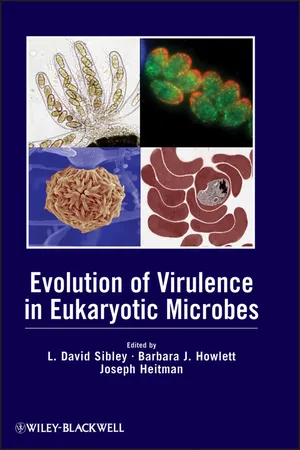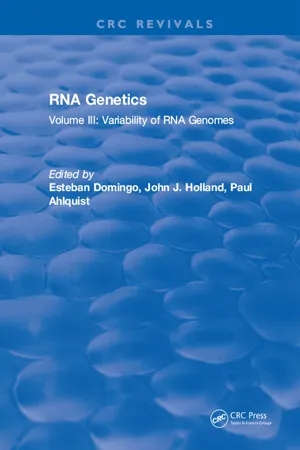Biological Sciences
Antigenic Variation
Antigenic variation refers to the ability of pathogens, such as viruses and bacteria, to alter their surface antigens in order to evade the host's immune response. This process allows the pathogen to avoid recognition by the immune system, leading to recurrent infections and making it challenging to develop effective vaccines or treatments.
Written by Perlego with AI-assistance
Related key terms
3 Key excerpts on "Antigenic Variation"
- eBook - ePub
Immunology
A Short Course
- Richard Coico(Author)
- 2021(Publication Date)
- Wiley-Blackwell(Publisher)
B‐cell superantigens that bind to and alter the expression of certain immunoglobulin gene families have also been described. Antigenic Variation Pathogens can escape the immune system by generating variants with different antigenic composition. This mechanism for evasion of host defenses is known as Antigenic Variation. Classic examples of pathogens that evade the host response by Antigenic Variation are influenza virus, HIV, Streptococcus pneumoniae, trypanosomes, and Group A streptococcus. Each of these pathogens provides an illustrative example of a mechanism for Antigenic Variation. In the case of Group A streptococcus, the M protein is required for virulence and functions by preventing phagocytosis through a mechanism that involves deposition of fibrinogen on the bacterial surface. M proteins elicit protective antibody but are antigenically variable, so that streptococcal infection with one strain does not elicit resistance to other strains. Influenza virus generates Antigenic Variation because it has a segmented RNA genome that can be resorted to yield virions expressing new combinations of the two main surface antigens: the hemagglutinin and neuraminidase surface proteins. Antigenic Variation for influenza virus occurs through both antigenic drift and antigenic shift. Antigenic drift is the result of point mutations in the influenza virus genome; these mutations produce antigenic changes in the hemagglutinin and neuraminidase. Antigenic shift occurs when influenza virus expresses a new allele of hemagglutinin or neuraminidase protein that results in a major antigenic change and the emergence of a new viral strain. The result of antigenic drift and shift for the influenza virus is that the virus changes rapidly, and one influenza infection does not confer protection against subsequent infection - eBook - ePub
- L. David Sibley, Barbara J. Howlett, Joseph Heitman(Authors)
- 2012(Publication Date)
- Wiley-Blackwell(Publisher)
Virulence can be defined as the cost a parasite levies on its host’s fitness. It is a key trait that is thought to arise as a consequence of the parasite population maximizing its abundance and longevity in the host. Although the parasite gains in transmission capacity from such maximization, the trade-off is host death or pathogenesis, leading to a decrease in parasite transmissibility. The trade-off hypothesis proposes that the parasite will evolve to optimum virulence, balancing host damage against transmissibility (Mackinnon and Read, 2004). In the complex relationships between parasite and host, it might be expected therefore that some mechanisms adapt to contribute to optimal virulence. Antigenic Variation is a parasite survival mechanism that appears to achieve such balance, working in concert with other factors such as growth rate and density-dependent effects. Here, we outline trypanosome population phenotypes associated with Antigenic Variation and the evolution of major trypanosome traits at the cellular and molecular levels. Using comparative genomics, we track the evolution of trypanosome Antigenic Variation to its current dominant role in balancing virulence and transmission, and we reveal interspecies differences in the generation of variation.Trypanosoma brucei , a single-cell eukaryote (i.e., protozoan), displays a classical type of Antigenic Variation that occurs also in other pathogens inhabiting the blood and facing the enormous scale, efficiency, and flexibility of adaptive immunity (Barry and McCulloch, 2001; Morrison et al., 2009). The parasite is covered completely by a dense coat composed of variant surface glycoprotein (VSG). The coat thwarts various innate immune mechanisms and, critically, shields necessarily conserved macromolecules from the immune system. As lethal antibodies arise against VSG, trypanosomes that have switched to expression of a distinct VSG coat survive and can proliferate. The switching process, which occurs in about every 100 dividing cells, is spontaneous and is preemptive of immunity, so that a diverse population is always present. In addition, variants emerge in a hierarchy, which is thought to result in chronic, rather than acute, overwhelming infection. All of these features are shared with many bacterial and protozoal pathogens; this form of Antigenic Variation is highly successful, having evolved convergently and independently many times (Deitsch et al., 2009).The VSG is highly diverse, especially in its N-terminal domain (∼350 amino acids), which is exposed to the host (Carrington et al., 1991; Marcello and Barry, 2007). There are two families of N-domain, termed a and b, which, respectively, have modal peptide identities of 10% and 15%. That these values are so low reflects three important features of the N-domain: It apparently has no function other than to form a dense coat; the protein is composed mostly of alpha-helix, which can be formed by a significant proportion of common amino acids; and it diversifies evenly along its entire length rather than by selection for the few epitopes exposed to immune pressure. The C-terminal domain (∼90–160 amino acids) is disposed toward the plasma membrane and is also diverse, although to a lesser extent. - eBook - ePub
RNA Genetics
Volume III: Variability of RNA Genomes
- Esteban Domingo(Author)
- 2018(Publication Date)
- CRC Press(Publisher)
Role of Genome Variation in Disease Chapter 7 Antigenic Variation IN INFLUENZA VIRUS HEMAGGLUTININS J. J. Skehel and D. C. Wiley TABLE OF CONTENTS I. Introduction II. Antigenic Shift III. Antigenic Drift References I. INTRODUCTION Antigenic Variation in influenza viruses primarily involves the hemagglutinin (HA) and neuraminidase (NA) glycoproteins of the virus membranes. Proteins enclosed by the membranes are not invariant; they can be distinguished antigenically by their partial reactions with heterologous, type-specific sera and by using monoclonal antibodies. 1, 2 The genes which specify these proteins can also be differentiated by nucleic acid hybridization 3 and their nucleotide sequences have been shown to differ in a limited number of analyses by up to 8%. 4, 5 By comparison, however, the amino acid sequences of the membrane glycoproteins differ more extensively, by up to 80%, and influenza A viruses are placed in subtypes on the basis of the exclusive reactions of their HAs and NAs with subtype-specific sera. 6 There are 13 antigenic subtypes of HA and nine of NA. All 13 HAs have been identified in viruses from avian species, and more restricted ranges have been obtained from horses, swine, and humans. The three subtypes of HA, H 1, H 2, and H 3, detected in humans since the first isolation of influenza viruses from humans in 1933 7 have been most extensively analyzed, and this review of Antigenic Variation in HAs will concentrate on them. The time periods of their prevalence were H 1, 1918 to 1957 and 1977 to the present; H 2 1957 to 1968; and H 3 1968 to the present. II. ANTIGENIC SHIFT The sudden appearance of “Asian” influenza viruses of the H 2 subtype in 1957 and of “Hong Kong” viruses of the H 3 subtype in 1968, and the displacement by them of viruses of the H 1 and H 2 subtypes, respectively, are commonly called antigenic shifts
Learn about this page
Index pages curate the most relevant extracts from our library of academic textbooks. They’ve been created using an in-house natural language model (NLM), each adding context and meaning to key research topics.


